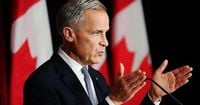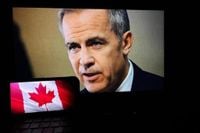Prime Minister Mark Carney has thrown down the gauntlet: Canada, he says, must double its non-U.S. exports within the next decade. In a string of speeches and press conferences this week, Carney detailed an ambitious new vision for Canada’s economy—one that pivots away from near-total reliance on its southern neighbor and leans into new global partnerships, infrastructure investments, and resource development. But as with any bold plan, the path forward is tangled with political skepticism, economic uncertainty, and the ever-present specter of U.S. tariffs.
Carney’s announcement came on October 22, 2025, during a rare prime-time televised address. He didn’t mince words about the urgency of the moment. "The jobs of workers in our industries most affected by U.S. tariffs — autos, steel, lumber — are under threat. Our businesses are holding back investments, restrained by the pall of uncertainty that is hanging over all of us," he told Canadians, according to the Associated Press. The timing was no accident: Carney’s government is set to unveil its first budget on November 4, a document many expect will be shaped by this new export agenda.
The numbers behind the challenge are stark. Currently, more than 75% of Canadian exports are bound for the U.S., a figure that has made Canada both prosperous and, in Carney’s words, vulnerable. Trade between the two countries is massive—nearly C$3.6 billion (US$2.7 billion) worth of goods and services cross the border every day, according to Benzinga. Canada is the largest export destination for 36 U.S. states and, in 2024, was the third-largest supplier of U.S. imports. But the Trump administration’s hardline approach to trade—raising tariffs to levels not seen since the Great Depression and openly threatening Canada’s economic sovereignty—has upended decades of “ever-closer economic relationship,” Carney said.
“The U.S. has fundamentally changed its approach to trade, raising its tariffs to levels last seen during the Great Depression,” Carney declared. “We have to take care of ourselves because we can’t rely on one foreign partner.” The prime minister’s candor about the risks of overdependence on the U.S. was echoed throughout his address. He also noted that Canada’s free trade deal with the U.S. (the USMCA) is up for a mandatory six-year review in 2026, adding yet another layer of uncertainty for Canadian exporters.
So, what’s the plan? Carney’s strategy hinges on diversifying Canada’s trade portfolio—specifically by re-engaging with global giants like India and China. "We are re-engaging with the global giants India and China," he said. The goal is to unlock an additional C$300 billion (US$214 billion) in trade over the next decade. But there’s more to it than just signing new deals. Carney outlined a sweeping infrastructure push, with a focus on building new energy and trade corridors, expanding key ports, and tapping into Canada’s vast reserves of critical minerals and natural resources.
On October 23, Carney provided more detail during a news conference in Bowmanville, Ontario. Standing alongside Ontario Premier Doug Ford, he pointed to federal support for major port projects—citing Grays Bay in Nunavut and the Port of Montreal’s expansion. He also highlighted the untapped potential of Ontario’s Ring of Fire, a mineral-rich region that could be key to Canada’s future as a supplier of critical minerals. "It can be critical minerals from the Ring of Fire and building that up. We’re working closely in terms of unlocking that enormous potential," Carney said, as reported by The Canadian Press.
Carney’s government is also preparing to fast-track new large industrial projects by streamlining permitting approvals. He promised to announce a list of these projects by November 10, aiming to spur what he described as "unprecedented" levels of private sector investment and a national building spree. "Part of those strategies that are consistent with the goal are new energy and trade corridors," Carney explained, signaling that infrastructure would be at the heart of this export revolution.
But not everyone is convinced. Conservative Leader Pierre Poilievre has been especially vocal in his skepticism. He argues that Canada’s single biggest net export is oil and gas—and that the only way to get those resources to non-U.S. markets is by building pipelines to tidewater. "We’re now seven months into Mark Carney’s term, and he still won’t even tell us if he supports a pipeline to tidewater," Poilievre charged. “I don’t know, other than pixie dust, what he expects to export overseas if he’s going to block the major infrastructure projects that are necessary to get our most valuable resources to the biggest and most lucrative non-American markets.” Poilievre has also called on Carney to repeal a series of laws passed by the previous Liberal government that he claims are holding back high-value exports.
Carney, for his part, has expressed support for ramping up liquefied natural gas (LNG) exports and insists his government is "just getting started" on getting major industrial projects built. He’s also been careful to reassure Canadians that the coming transformation won’t leave vulnerable populations behind. He promised to maintain existing social supports, such as health transfers to provinces and child care support, even as the country embarks on this economic pivot.
Still, Carney has been upfront about the challenges ahead. "To be clear, we won’t transform our economy easily or in a few months — it will take some sacrifices and some time,” he cautioned. In a moment of candor with reporters, he admitted, "We will have to do less of some of the things we want to do, so we can do more of what we must do to build a bigger, better Canada." Yet, he stopped short of providing specifics, deferring details to the upcoming budget announcement.
Political hurdles loom large. The Liberal party, which Carney leads, is a few seats shy of a majority in Parliament. That means the success of his budget—and, by extension, his entire export diversification plan—may depend on securing support from other parties. The party’s House leader has publicly expressed concern about whether opposition parties will allow the budget to pass.
Meanwhile, sectoral trade talks with the U.S. continue, with some Canadian officials expressing cautious optimism about progress in areas like steel, aluminum, and energy. President Donald Trump, after meeting Carney in October, hinted at a possible breakthrough but stopped short of offering concrete assurances. The shadow of U.S. tariffs remains, and Canadian businesses are still holding back on investments, wary of the uncertainty that clouds the future of cross-border commerce.
For now, Carney is betting that bold action, strategic investments, and a willingness to make tough choices can chart a new course for Canada’s economy—one less tethered to the whims of a single partner. Whether his vision can overcome political opposition and global headwinds remains to be seen, but one thing is clear: the era of business as usual is over, and Canada is bracing for a new chapter in its economic story.

